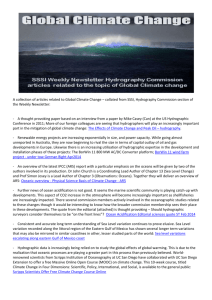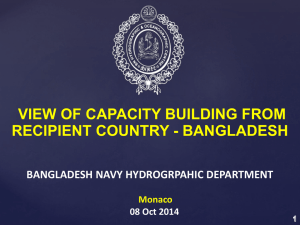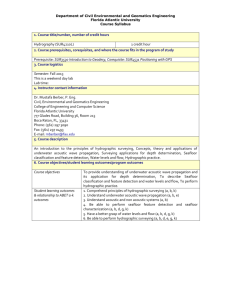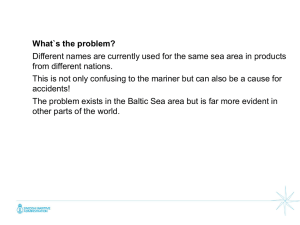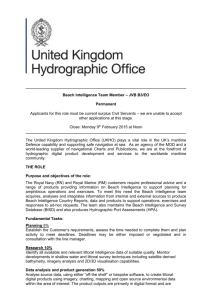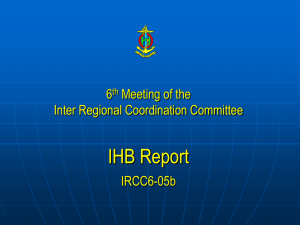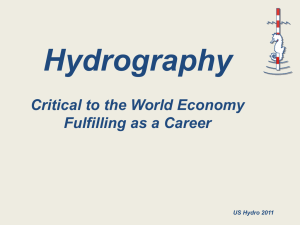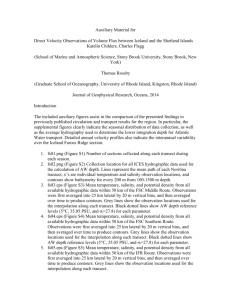State of Hydrographic Capacity
advertisement
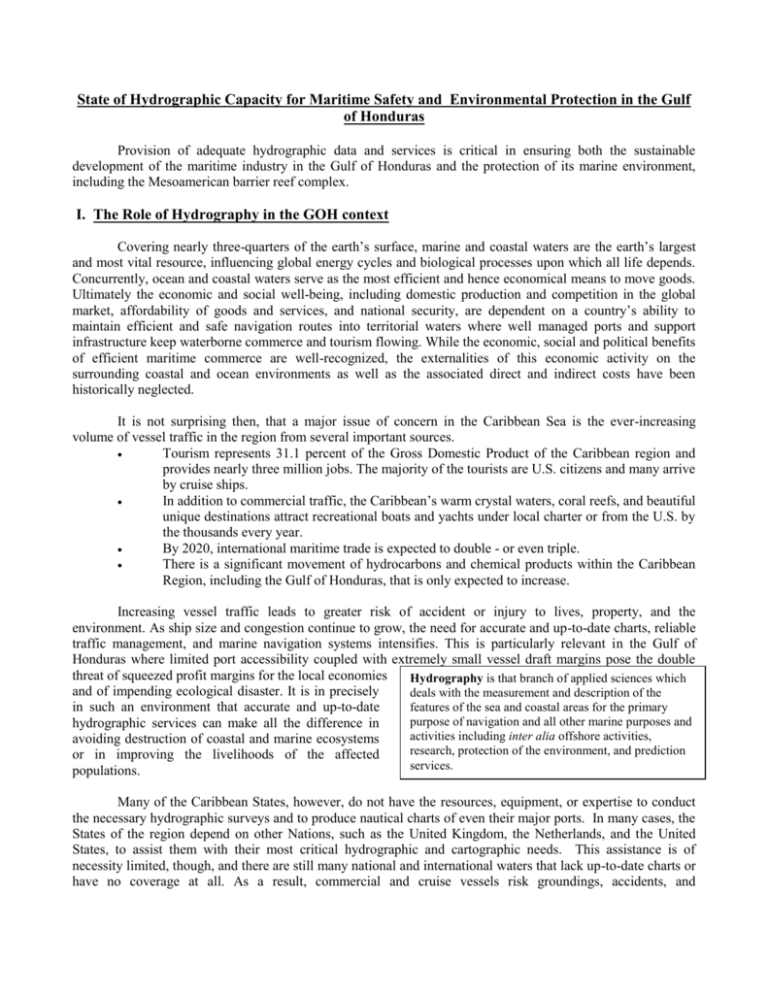
State of Hydrographic Capacity for Maritime Safety and Environmental Protection in the Gulf of Honduras Provision of adequate hydrographic data and services is critical in ensuring both the sustainable development of the maritime industry in the Gulf of Honduras and the protection of its marine environment, including the Mesoamerican barrier reef complex. I. The Role of Hydrography in the GOH context Covering nearly three-quarters of the earth’s surface, marine and coastal waters are the earth’s largest and most vital resource, influencing global energy cycles and biological processes upon which all life depends. Concurrently, ocean and coastal waters serve as the most efficient and hence economical means to move goods. Ultimately the economic and social well-being, including domestic production and competition in the global market, affordability of goods and services, and national security, are dependent on a country’s ability to maintain efficient and safe navigation routes into territorial waters where well managed ports and support infrastructure keep waterborne commerce and tourism flowing. While the economic, social and political benefits of efficient maritime commerce are well-recognized, the externalities of this economic activity on the surrounding coastal and ocean environments as well as the associated direct and indirect costs have been historically neglected. It is not surprising then, that a major issue of concern in the Caribbean Sea is the ever-increasing volume of vessel traffic in the region from several important sources. Tourism represents 31.1 percent of the Gross Domestic Product of the Caribbean region and provides nearly three million jobs. The majority of the tourists are U.S. citizens and many arrive by cruise ships. In addition to commercial traffic, the Caribbean’s warm crystal waters, coral reefs, and beautiful unique destinations attract recreational boats and yachts under local charter or from the U.S. by the thousands every year. By 2020, international maritime trade is expected to double - or even triple. There is a significant movement of hydrocarbons and chemical products within the Caribbean Region, including the Gulf of Honduras, that is only expected to increase. Increasing vessel traffic leads to greater risk of accident or injury to lives, property, and the environment. As ship size and congestion continue to grow, the need for accurate and up-to-date charts, reliable traffic management, and marine navigation systems intensifies. This is particularly relevant in the Gulf of Honduras where limited port accessibility coupled with extremely small vessel draft margins pose the double threat of squeezed profit margins for the local economies Hydrography is that branch of applied sciences which and of impending ecological disaster. It is in precisely deals with the measurement and description of the in such an environment that accurate and up-to-date features of the sea and coastal areas for the primary purpose of navigation and all other marine purposes and hydrographic services can make all the difference in activities including inter alia offshore activities, avoiding destruction of coastal and marine ecosystems research, protection of the environment, and prediction or in improving the livelihoods of the affected services. populations. Many of the Caribbean States, however, do not have the resources, equipment, or expertise to conduct the necessary hydrographic surveys and to produce nautical charts of even their major ports. In many cases, the States of the region depend on other Nations, such as the United Kingdom, the Netherlands, and the United States, to assist them with their most critical hydrographic and cartographic needs. This assistance is of necessity limited, though, and there are still many national and international waters that lack up-to-date charts or have no coverage at all. As a result, commercial and cruise vessels risk groundings, accidents, and environmental damage if they enter or transit these areas. Moreover, where the risk is too great, vessels avoid ports and harbors regardless of facilities and quality of service they offer, thereby severely impacting the local economies – a situation well familiar in the Gulf of Honduras. The role and importance of adequate hydrographic data and services, however, extends well beyond its significance for maritime commerce and tourism and for navigation safety in the Gulf of Honduras. Looking at the full spectrum of hydrographic-data-based products, one easily identifies hydrography’s core function in developing virtually any and every expert application in support of marine and coastal research, management, and conservation: Hydrographic support for Biogeography primary data layer for development of Biogeography and habitat characterization strongly depend on marine and coastal GIS-based bathymetric data availability. Bathymetry plays a key role in defining Essential Habitats (EH) by supporting determination of the preferred environmental information system; depth at which organisms live. Moreover, species differ in their preferences for high or low rugosity (terrain roughness) environments. Thus, the Biogeography Program’s work in the U.S. Caribbean has demonstrated that fish distribution and terrain profile are closely correlated and that bathymetry (in the form of coral reef structure) plays a critical role in defining fish EH as both protection and food source. This work is now being used for the development of marine protected areas (MPA). primary data layers in oceanographic modeling, non-point source pollution vector mapping, etc; primary data layers for oil-spill management tools, including trajectory analysis and vulnerability maps; Similarly essential is the role that bathymetry plays in generating high resolution data sets fueling biogeography research and applications (such as benthic and essential fish habitat identification and delineation, habitat suitability modeling, species distribution, and habitat-change mapping); benthic and coral reef ecosystem habitat maps from aerial and satellite imagery – maps that are then used for MPA and coral reef protection and management activities. The same holds true for the creation of computerized image analysis software, where bathymetric data is used in developing mathematical algorithms that control for the light attenuation by the water column. As the ongoing oceanographic modeling and research work under the broader Mesoamerican Barrier Reef System (MBRS) initiative has demonstrated, adequate hydrographic data is a key building block for oceanographic modeling and research. The lack Electronic Navigation Chart (ENC) of such data for the Gulf of Honduras makes The ENC is a “smart chart” that gives the user much more valuable, accurate, it difficult to approximate and test coastal and complete information than traditional charts. Built to international boundary conditions and to integrate standards, ENCs are an extremely accurate and detailed chart database that oceanographic and watershed dynamics can be displayed by electronic charting systems aboard ships. ENCs store an models. This is especially true in the case of actual chart feature, its latitude and longitude, and other descriptive information. ENCs are produced using digitized vector data that contains near-coastal waters and the waters between descriptive and positioning characteristics allowing the electronic chart the coast and MBRS in particular. Past experience in the Mediterranean, the Black, and the Red Seas has also taught us that acquiring adequate hydrographic information is a critical factor in determining success or failure when analyzing pollution contingencies and building regional capacity for transboundary response to oil spills and other contaminants. Moreover, failure to integrate capacity building in areas such as coastal and marine vulnerability mapping and software to recognize features, water depths, and accurate geographic positions and provide a warning if a course correction is required. A navigation system using an ENC would "know" that a dangerous wreck is in the path of a vessel, as well as how much water covers the wreck. In fact, most maritime experts agree that if an ENC-fueled electronic chart system were operational on the bridge of the Exxon Valdez disaster could have been averted. An ENC system can also check planned routes to see if they cross or pass too near obstructions, sound alarms if a vessel strays too close to dangerous features like a shallow area, and inform the mariner about warnings and regulations in transit areas. Importantly, the ENC represents a major step in providing essential data to mariners and other users such as information on pollution restrictions, protected or fragile marine habitats, endangered species, etc. trajectory analysis with hydrographic capacity building has invariably resulted in a waste of resources over the long run. Finally, the juxtaposition of the state of navigation and the state of available hydrographic coverage and capacity in the Gulf of Honduras makes it paramount that one looks not only at existing hydrographic information but also look at the region’s immediate and future data acquisition and chart production needs. Serious safety and environmental risks can be mitigated by the provision of accurate charts and navigation services that evolve from paper charts in the short run to Electronic Navigation Charts fueling the dual needs of safe navigation and of environmentally sustainable marine habitat and resource management (Appendix 2 offers web links with examples of hydrographic data and ENC multiple uses in the United States). II. Hydrographic Surveys and Data Availability in the Region Due to the lack of national capacity, hydrographic data acquisition and product development in most of Latin America in general and the Gulf of Honduras in particular, to-date those functions have been mainly carried out under bilateral agreements with the US, UK, and other foreign hydrographic offices. Over time, this has resulted in discontinuity lack of uniform reliability, and data inaccessibility that now hampers not only the economic development in the region but also its environmental management and habitat protection efforts. A particularly pervasive problem in this respect is the lack of electronic data and the capacity to produce such data and derive from it value-added products that support both navigation safety and resource conservation and management objectives. Fig 2.1 1998 - 2002 Large Scale 1977 - 1998 Large Scale 1998 - 2002 Medium/Small Scale 1977 - 1998 Medium/Small Scale Fig. 2.1 offers guidance on hydrographic surveys carried on in the Gulf of Honduras over the periods 1977-1998 and 1998-2002 as well as to the availability of both large and medium-to-small scale source data sets. Time delineation is significant since source data from the 70s and part of the 80s has not been compiled to meet today’s requirements for geo-spatial requirements, including data density. That data is also not available in digital format and therefore largely unsuitable for non-navigation applications. Importantly, natural accretion processes and extreme weather events such as the 1998 Hurricane Mitch bring about sometimes significant changes in the coastal area bottom that render old data compilations obsolete and even dangerous. Furthermore, since most of the above depicted surveys were done under bilateral agreements by the US Navy Hydrographic Office (NAVOCEANO) and compiled into nautical charts by the US National Imagery and Mapping Agency (NIMA), not all source data is necessarily available with the respective coastal states or, if available, it is not in electronic format. The same holds true for the nautical charts derived from that data. Keeping this in mind, the table below provides inventory on survey/data availability on State-by-State basis: Table 2.1 State Coastal Surveys Ports, harbors and approaches Belize Guatemala Port/Area Source Data availability Digital coverage Survey information/ Surveying needs Belize City Harbor Big Creek In-country Unknown 100% Unknown Puerto Barrios Puerto Santo Thomas de Castilla Bahia Manabique and approaches Puerto Cortez In-country In-country 0% 0% Surveyed by Belize 1998, 2002 IHO Order1 single beam and side scan sonar; data gaps exist in Harbor area and strategic charting plan needed for future port infrastructure development and navigational safety. Inadequate coverage: most recent data from 1979. All areas need to be re-surveyed In-country 0% In-country 100% Puerto Cortez Approaches In-country 100% Tela La Ceiba Puerto Castia / Trujillo Bay Islands In-country In-country In-country 0% 100% 100% In-country Coast-wide survey (red band on fig 1.1) In-country 100% in limited areas 0% Honduras Honduras Surveyed by Honduras (ENP) May 1998 IHO order2, single beam and side scan sonar; does not meet international standards. Additionally dredging activity and Hurricane Mitch have affected the harbor area since last survey Surveyed by Honduras (ENP) in June 1999 IHO order2 single beam, does not meet international standards. Needs to be re-surveyed Being surveyed (ENP) IHO order unknown Surveyed (ENP) IHO order unknown Coxen Hole, French Harbor Roatan surveyed by ENP 2002 IHO 2 single beam and side scan sonar. An 1984-85 survey carried out by the US. Only some of the data could be used for conversion into digital format. III. Institutions Involved in Hydrographic work in the Region Table 2.1 Country Guatemala Honduras Belize Institutions Involved in Hydrographic work Ministry of Defense Guatemalan Navy Instituto Geografico Nacional Empresa Portuatria Quetzal Empresa Portuaria Nacional Instituto Geografico Nacional Unknown IHO Membership Member Not a member Not a member IV. Nautical Chart Availability in the Region Table 4.1 Country Source Belize NIMA No. 28167 Ambergris Cay To Pelican Cays 1:150,000 NIMA IGN, Guatemalla IGN, Guatemalla NIMA NIMA No. 28168 Gua-02 Belice City Harbor Rio Dulce To Livingston 1:40,000 1:7,500 Gua-03 1:15,000 NIMA No. 28165 NIMA No. 28161 Puerto Santo Tomas de Castilla To Puerto Barrios Teta To Pelican Cays Approaches To Puerto Barrios And Santo Tomas De Castilla (Guatemala – Belize) Puerto Barrios And Santo Tomas De Castilla De Galvez (Guatemala East-Coast) Puerto De Teta And Approache Puerto De Teta NIMA No. 28163 1:20,000 NIMA NIMA NIMA No. 28143 No. 28142 NO.28144 Approaches To Puerto Cortes (Gulf of Honduras) Isla De Utila (Honduras) Puerto Castilla Port Of La Ceiba NIMA NIMA NIMA No. 28151 No.28150 A-B No. 28140 Approaches To Puerto Castilla 1:80,000 Teta Tobarra De Caratasca (Omega) 1:300,000 1:20,000 Northem Reaches To Cabo Gracias 1:125,000 De Dios NIMA No. 28125 NIMA No. 28154 Caribbean Sea Honduras Isla De Guanaja Approaches To La Ceiba Guatemala Chart No No. 28162 No. 28164 Honduras AREA Scale 1:150,000 1:50,000 Comments Source data from1978; outdated geo-reference Source data from 1979 Source data from 1965 with limited update in 1995 1:15,000 1:15,000 1:37,420 1:20,000 1:15,000 1:35,000 1:80,000 All of the above listed charts are available only in paper format. A case-by-case special request from the Coastal State is necessary for NIMA charts to be converted to a digital format or/and released. Cost of such conversion ranges from $20,000 to $ 40,000 per chart. V. Existing International laws and regulations, specifically regarding marine transport: All three States involved in the Environmental Protection and Maritime Transport Pollution Control in the Gulf of Honduras Project are Parties to United Nations Convention on the Law of the Sea (UNCLOS). As outlined in the table below, while there is more to be desired in terms of the three States’ accession to a number of International Maritime Organization (IMO)-sanctioned conventions on navigation safety and marine protection, particularly as related to oil spills, Belize, Guatemala, and Honduras are also Parties to the key MARPOL 73/78 and Safety of Life At Sea (SOLAS) conventions. SOLAS Chapter V on Safety of Navigation, Regulation 9, in particular sets the mandate and legal precedent for hydrographic capacity building at national and regional levels by requiring that Contracting Parties provide hydrographic services and co-ordinate and cooperated their efforts. x Belize Guatemala Honduras VI. x x x x x x x x x x x x x x x x x x x x x x x x x x x x x x x x x x x x x x x x x x Anti Fouling 01 OPRC/HNS 2000 Bunkers Convention 01 HNS Convention 96 OPRC Convention 90 FUND Protocol 92 FUND Protocol 76 FUND Convention 71 CLC Protocol 92 CLC Protocol 76 CLC Convention 69 INTERVENTION Convention 69 London Convention Protocol 96 London Convention 72 MARPOL Protocol 97 (Annex VI) MARPOL 73/78 (Annex V) MARPOL 73/78 (Annex IV) MARPOL 73/78 (Annex III) MARPOL 73/78 (Annex I/II) INMARSAT Convention 76 SAR Convention 79 STCW Convention 78 SFV Protocol 93 CSC Convention 72 COLREG Convention 72 TONNAGE Convention 69 LOAD LINES Protocol 88 LOAD LINES Convention 66 Stockholm Agreement 96 SOLAS Protocol 88 SOLAS Protocol 78 SOLAS Convention 74 IMO amendments 93 IMO amendments 91 IMO Convention 48 Table 5.1 x Hydrographic capacity and Gap Analysis in the Gulf of Honduras As a regional arm of the International Hydrographic Organization (IHO), the Mesoamerican and Caribbean Sea Hydrographic Commission (MACHC) looks to facilitate sustainable capacity development and technology transfer that will stimulate the collection of quality hydrographic data based on international standards for navigation safety and protection of the marine environment. Based on the potentially positive impact of the proposed Gulf of Honduras project on hydrographic activity for the region, the MACHC has taken the opportunity to review the current hydrographic capacity for the three countries of interest, Belize, Guatemala, and Honduras. The goal of the review was to determine if the current capacity for hydrographic surveying including institutional capacity, product production and information flow was sufficient to meet international standards along with the purported goals and objectives of the proposed project; we consider these to not be mutually exclusive. The findings would then be synthesized based on a country’s ability to meet the standards of the International Hydrographic Organization and where necessary make recommendations that could provide direction for the development of hydrographic capabilities congruent with IHO standards and the goals and objectives of the proposed GOH project. Methodology: The information below was collected by means of an open-ended questionnaire survey (appendix A) that was distributed to strategic points of contact in each country. The survey queried the country across a spectrum of information that the commission considers essential for a sustainable hydrographic effort including: existing institutional capacity (national and regional), current data availability, quality, and accessibility, Technical equipment and personnel proficiency for the collection of hydrographic data, and the technical equipment and personnel proficiency for product production and information assimilation and dissemination. The survey focused on the national needs as well as those for the priority ports of the proposed project. Each country with the exception of Belize filled out the survey and the information was compiled into the matrix that preceded the filled out questionnaire. The completed surveys are available in English and Spanish. From Guatemala El Capitan de Fragata Tyrone Rene Hidalgo Caceres completed the questionnaire, from Honduras the Director of the National Port Authority (ENP) completed the survey, and from Belize Mr. Brent von Twistern from the U.S Naval Oceanographic Office completed the questionnaire based upon his experience during hydrographic surveys with the Belize government in 1998, and 2002. The information for Belize should be considered preliminary and it is the hope of this commission to have the matrix completed by all the relevant ministries within Belize when the opportunity presents itself. GOH Project: Hydrographic component gap analysis -- Belize Personnel Training needed Training needed Workstations needed Workstations needed Workstations needed Training needed Technical Personnel Personnel and training Technical Data Geog. focus National level Hydrographic equipment suite needed Personnel and training One worker at the MNREI Personnel and training No Hydrographic equipment Requires a hydrographic survey to meet internatinal standards Hydrographic equipment suite needed No vessel Requires a hydrographic survey to meet internatinal standards Product dev. Hydrographic equipment suite needed One worker at the MNREI Belize Ctiy No Hydrographic equipment Data acquisition Big Creek (Bahia Matique) Institutional capacity Devlopment of National hydrogrraphic commission to coordinate efforts amoung Ministries and Internationally funded projects in Belize. Development of national policy and mandates to allocate resources Personnel proficiency Inadequate Related initiatives Limited products available No digital data None Refer to Table 2.1 No vessel Inadequate Data available digital format some data gaps exist One worker at the MNREI Inadequate Refer to Table 2.1 No Hydrographic equipment None Do not have national or strategic charting plan Technical equipment No vessel None Refer to Table 2.1 Product development Personnel proficiency Data acquisition Technical equipment Geog. focus Data availability, quality, accessibility, etc. None MNREI and Port rely on International Survey Division (HYCOOP) at the U.S Naval Oceanographic Office for equipment, software and technical assistance. Contract surveys provide data to port authority National level Port Authority and Ministry of Natural Resources Environment and Industry (MNREI) survey, Port Authority maintains data; institutions conduct survey work independently do not share resources. No Current effort to integrate through National hydrographic commission Belize City No affiliation with IHO or MACHC party to SOLAS, UNCLOS and MARPOL 73/78 Needs Big Creek Existing Capabilities Institutional capacity (mandates, organizations, coordination, access, resources, ability to perform and deliver, etc.) GOH Project: Hydrographic component gap analysis -- Guatemala Personnel Workstations needed Training needed Workstations needed Training needed Workstations needed Hydrographic equipment suite needed Requires a hydrographic survey to meet internatinal standards Hydrographic equipment suite needed Requires a hydrographic survey to meet internatinal standards Training needed Technical Personnel Technical Product dev. Hydrographic equipment suite needed Data Geog. focus National level Puerto Barrios Personnel proficiency Data acquisition Puerto Santo Tomas (Bahia Matique) No Hydrographic equipment Four officers Six sailors; Four workers at Port Institutional capacity Limited products available No digital data Navy vessels Continue work with National Hydrographic Commission to further working relationships in hydrography both natinally with links to the region Refer to Table 2.1 No Hydrographic equipment Four officers Six sailors; Four workers at Port Related initiatives Limited products available No digital data Navy vessels None Refer to Table 2.1 No Hydrographic equipment Inadequate Do not have strategic charting plan Inadequate Four officers Six sailors; Four workers at Port Technical equipment Navy vessels None Personnel proficiency Refer to Table 2.1 None Technical equipment Geog. focus Data acquisition Inadequate Working with COCATRAM to look for economic support within the European community Product development Data availability, quality, accessibility, etc. None Navy relies on International Survey Division (HYCOOP) at the U.S Naval Oceanographic Office; Port Authority has Budget National level Navy and Port Authority survey, Port Authority maintains data; institutions conduct survey work independently do not share resources. Current effort to integrate through National hydrographic commission Puerto Barrios IHO member state and party to SOLAS, UNCLOS and MARPOL 73/78 Needs Puerto Santo Tomas Existing Capabilities Institutional capacity (mandates, organizations, coordination, access, resources, ability to perform and deliver, etc.) GOH Project: Hydrographic component gap analysis -- Honduras Training needed Training needed Workstations needed Technical Personnel Product dev. Workstations needed Personnel Six workers Data Geog. focus Institutional capacity Technical Six workers Planned surveys Personnel proficiency Inadequate National level Requires a hydrographic survey to meet international standards Hydrographic equipment suite needed The National Port Authority relies on HYCOOP for equipment and contracted vessel time Six workers from the Port Hydrographic equipment suite needed Including hardware and software No Hydrographic equipment Data acquisition Puerto Cortes Puerto Santo Tomas (Bahia Matique) Data does not meet IHO standards for Harbors No vessel Organizational policy and mandates need to be developed at the national level to support capacity building, and resurce needs for hydrographic surveys; national and regional coordination Data is available and in Digital format Six workers from the Port Inadequate Refer to Table 2.1 Technical equipment have a national charting plan no strategic charting plan No Hydrographic equipment None No vessel Product development Personnel proficiency Refer to Table 2.1 Technical equipment Data acquisition None Port Authority relies has a budget but counts on International Survey Division (HYCOOP) at the U.S Naval Oceanographic Office for equipment, software and technical assistance and the U.S National Imaging and Mapping Agency (NIMA) for chart production Puerto Cortes Port Authority collects, processes, disseminates hydrographic data National level Associate IHO member state and party to SOLAS, UNCLOS and MARPOL 73/78 Data availability, quality, accessibility, etc. Related initiatives Needs Geog. focus Existing Capabilities Institutional capacity (mandates, organizations, coordination, access, resources, ability to perform and deliver, etc.) GOH Project: Hydrographic component gap analysis – Summary findings Belize Institutional capacity Data gaps Survey technical capacity ENC development Marine GIS/ Other product development ~ V partial gaps major gaps Guatemala Honduras V V V V V major ports ~ V ~ coastal areas V V V vessels V equipment V V V skills V V V skills V V V equipment V V V skills V V V equipment V V V mandates and policies V resources V organizations V coordination & collaboration V Related initiatives Personnel proficiency National level Personnel Data acquisition Technical Personnel Product development Technical Data Geog. focus Institutional capacity Data acquisition / Product development / Updates / Institutional alignment / Dissemination and access Data acquisition Technical equipment Personnel proficiency Technical equipment Geog. focus Data availabili ty, quality, accessibi lity, etc. Electronic chart data for navigation safely and GIS conversion capacity for other uses National level Existing Capabilities Institutional capacity (mandates, organizations, coordination, access, resources, ability to perform and deliver, etc.) Puerto Cortez Puerto Cortez APPENDIX 1 GOH Project: Hydrographic component gap analysis Needs Product dev. EXISTING NATIONAL CAPABILITIES INSTITUTIONAL CAPACITY (sample questions) Existing mandates/laws/policies for the collection and processing of hydrographic data and for chart production? Organization(s) responsible for 1) data collection, 2) data analysis and processing, 3) chart production, 4) data and chart dissemination? If more than one organization: o what is the relationship? Reporting hierarchy? o what is the effectiveness of communication, coordination, and cooperation that exists between the several responsible entities? o Are resources shared with other agencies (e.g., mapping, surveying), and if so, how is data accessed? Please describe. Sources and availability of operational and research and development budget/resources for the individual organizations? Is mapping and/or survey data acquired by commercial survey activities also provided to government agencies? If so, how is it accessed and processed? Does your country have a national survey and/or charting plan? If so, please provide a copy or provide a brief description.. Capacity (including resources) to meet national survey/charting priorities? Capacity to identify means of improving shortfalls in training/equipment? Regional and international cooperative agreements and assistance sources? Other relevant information? DATA (Please answer these questions regarding data availability at the 1) national level and 2) for Puerto Cortez specifically) Have hydrographic surveying priorities been established at national level or within a regional context Source data availability by 1) area, 2) time of surveys, 3) survey methods, 4) quality (does it meet International Hydrographic Organization standards?), 5) format (digital/paper)? Status of information flow and updates to charts? Source data accessibility? Existing data not yet charted Data sharing provisions if any? Data sharing arrangement? Hydrographic products availability and accessibility? Experience with non-navigation use of hydrographic data and related sharing agreements if any? Other information? TECHNICAL EQUIPMENT FOR DATA ACQUISITION AND PROCESSING (Please answer these questions for 1) national level and 2) resources that could be specifically dedicated to work on Puerto Cortez in the short-to-medium term) At the national level: How many vessels are available to perform hydrograhpic surveying? Who owns or operates them? What kind of hydrograhpic survey equipment is instaled? multibeam sonar side-scan sonar single-beam sonar GPS, Differential GPS tide gages For Puerto Cortez specifically: How many vessels are available to perform hydrographic surveying? Who owns or operates them? What kind of hydrographic survey equipment is installed? multibeam sonar side-scan sonar single-beam sonar GPS, Differential GPS tide gages EXISTING PERSONNEL TRAINING AND PROFICIENCY FOR DATA ACQUISITION AND PROCESSING (Please answer these questions for 1) national level and 2) resources that could be specifically dedicated to work on Puerto Cortez in the short-to-medium term) How many trained personnel at the national level are available to: Acquire hydrographic data? Process and validate the data? Please describe the current level of personnel expertise or level of training required to operate the equipment listed in the previous section For Puerto Cortez, how many trained personnel are available to: Acquire hydrographic data? Process and validate the data? Please describe the current level of personnel expertise or level of training required to operate the equipment listed in the previous section TECHNICAL EQUIPMENT FOR ENC AND MARINE GIS DEVELOPMENT (Please answer these questions for 1) national level and 2) resources that could be specifically dedicated to work on Puerto Cortez in the short-to-medium term) What equipment is available at national level to: Process the data? Produce paper nautical charts? Capture S-57 data where necessary from source material for conversion to ENC. Data validation? Produce electronic navigational charts? Maintain charts? Conduct training as required? Data conversion for GIS and modeling applications computer hardware GIS software Database management tools Data access and client outreach/cultivation What is the currently available equipment that can be dedicated for work specifically on Puerto Cortez in the short-to-medium term: Process the data? Produce paper nautical charts? Capture S-57 data where necessary from source material for conversion to ENC. Data validation? Produce electronic navigational charts? Maintain charts? Conduct training as required? Data conversion for GIS and modeling applications computer hardware GIS software Database management tools Data access and client outreach/cultivation EXISTING PERSONNEL TRAINING AND PROFICIENCY FOR ENC AND MARINE GIS DEVELOPMENT (Please answer these questions for 1) national level and 2) resources that could be specifically dedicated to work on Puerto Cortez in the short-to-medium term) How many trained personnel at the national level are available to: Process the survey data? Produce paper nautical charts? Capture S-57 data where necessary from source material for conversion to ENC. Data validation? Produce electronic navigational charts? Maintain charts? Conduct training as required? Data conversion for GIS and modeling applications Data access and client outreach/cultivation For Puerto Cortez, how many trained personnel are available to: Process the survey data? Produce paper nautical charts? Capture S-57 data where necessary from source material for conversion to ENC. Data validation? Produce electronic navigational charts? Maintain charts? Conduct training as required? Data conversion for GIS and modeling applications Data access and client outreach/cultivation RELATED INITIATIVES Planned and ongoing survey activities? Status? Planned and ongoing product development activities? Status? National and/or regional cooperative discussions/initiatives? GAPS and NEEDS Following the Master Matrix above, please expand below on the information required by the individual boxes at both national level and Port-specific level (including in terms of approaches to the access channels, access channels, and turning basins). The two key areas to consider when identifying gaps and needs are Safety of navigation AND capacity to support Marine GIS and Environmental information system. Specific consideration has to be given to: Data acquisition needs Product development needs Information flow and chart update needs Institutional alignment needs Data/Product dissemination and access needs I. INSTITUTIONAL CAPACITY (sample questions) II. Statutory needs? Structural needs? Resource needs? Inter-organizational communication and coordination needs? Capacity to identify and work with user communities? Etc. DATA (Please answer these questions regarding data acquisition gaps and needs at the 1) national level and 2) for Puerto Cortez specifically) III. TECHNICAL EQUIPMENT FOR DATA ACQUISITION AND PROCESSING (Please answer these questions for 1) national level and 2) resources that is needed to cover Puerto Cortez within the short-to-medium term) What are the current limitations and/or future needs required to support other governmental activities such as marine environmental protection, coastal zone management, oil spill contingency planning, natural resource/ecological database Equipment needed Training of personnel (indicate what areas) other? For Puerto Cortez, what are the gaps or future needs in order to fully support navigation safety? Equipment needed Training of personnel (indicate what areas) other? What are the current limitations and/or future needs required to support other governmental activities such as marine environmental protection, coastal zone management, oil spill contingency planning, natural resource/ecological database IV. EXISTING PERSONNEL TRAINING AND PROFICIENCY FOR DATA ACQUISITION AND PROCESSING (Please answer these questions for 1) national level and 2) resources that are necessary to cover Puerto Cortez within the short-to-medium term) How many trained personnel at the national level are available to: Acquire hydrographic data? Process the data? At the national level, what are the gaps or future needs in order to fully support navigation safety and provide hydrographic information for non-navigation purposes (oil spill contingency planning, marine environmental GIS?) For Puerto Cortez, how many trained personnel are available to: Acquire hydrographic data? Process the data? For Puerto Cortez, what are the gaps or future needs in order to fully support navigation safety and provide hydrographic information for non-navigation purposes (oil spill contingency planning, marine environmental GIS?) V. TECHNICAL EQUIPMENT NEEDS FOR ENC AND MARINE GIS DEVELOPMENT (Please answer these questions for 1) national level and 2) resources that could need to be specifically dedicated to cover Puerto Cortez within the short-tomedium term) Workstations? VI. PERSONNEL TRAINING AND PROFICIENCY NEEDS FOR ENC AND MARINE GIS DEVELOPMENT (Please answer these questions for 1) national level and 2) resources that could be specifically dedicated to work on Puerto Cortez in the short-to-medium term) Training? APPENDIX 2 US National Ocean Service Hydrographic Data and Electronic Navigational Carts (ENC) Dual Use for Coastal Managers Uses of Hydrographic Survey Data: http://www.ngdc.noaa.gov/mgg/bathymetry/hydro.html Applications: migration and habitat studies of fish and marine mammals; delineation of bottom features for commercial fishermen; earthquake and fault studies; sediment and pollutant studies; studies of storm surge and tsunami effects; oil, gas and mineral exploration; coastal planning and ecosystem evaluations; color imaging and animation (fly-by). Integrated Bathymetric/Topographic/Shoreline: http://chartmaker.ncd.noaa.gov/BathyTopo A user-friendly tool that blends bathymetric and topographic data sets into a digital elevation model. It can support storm surge modeling, hurricane evacuation planning, port management, habitat restoration planning, storm impact analysis, permitting, setback lines (exclusions zones) assessment and determination, boundary determination, environmental and natural resource analysis, coastal erosion analysis, etc. Nautical Chart Extension for ArcView 3.x: http://www.csc.noaa.gov/products/chartview The NOAA navigational charts displayed as images can provide a useful background layer for ocean and coastal geographic information system (GIS) Projects. A problem for the GIS community has been that the current BSB format was not widely supported by mapping software vendors. To address the issue of viewing these BSB images in a common desktop GIS, a freely distributed ArcView® 3.x extension has been created that allows the desktop GIS users to read a BSB-formatted chart. Digital NOAA Nautical Chart ReProjections: http://www.csc.noaa.gov/crs/Products/chartreproj A stand-alone application has been developed to reProject digital NOAA nautical charts. This application is a companion to an ArcView® extension, chartviewer, developed to allow the display of BSB format nautical charts in ArcView®. An extension has been developed to read a BSB format file, re-project it to users specification, and output a new BSB or TIFF format file. Included is the ability to change datum. Electronic Navigational Charts: http://chartmaker.ncd.noaa.gov/mcd/enc/index.htm A fully integrated vector base maps for use in geographic information systems (GIS) that are needed for coastal management or other purposes. The NOAA ENCs are in the International Hydrographic Office (IHO) S-57 international exchange format and comply with the NOAA ENC Product Specification. Coastal Map Data Layer: http://chartmaker.ncd.noaa.gov Designed to provide public access to an up-to-date, digital, and geo-referenced coastal map data layer and to support NOAA’s strategic goal of sustaining healthy coasts. These non-proprietary navigational chart images are to be used as backdrops for GIS-derived products and to provide a clear view of the basic topographic and hydrographic data of all near-shore geographic areas of the U.S. The Coastal Map Series is produced directly from the current editions of NOS nautical charts with all the navigational symbols and aids removed. They are prepared as geo-referenced TIF images. Extracted Vector Shoreline: http://chartmaker.ncd.noaa.gov Designed to provide shoreline data to a variety of users in an industry standard format. Digital vector data is extracted from current nautical charts and includes both mean high water lines and mean low water lines to produce a complete data set. Formatted for standard GIS queries and functionality. Marine Modeling and Analysis Programs (MMAP) forecasting: http://chartmaker.ncd.noaa.gov/csdl/op/welcome.html Develops, improves, and applies analytical methods and numerical techniques for the analysis, simulation and real-time forecasting of oceanographic (e.g. water levels, currents, temperature, salinity), atmospheric (e.g. winds, sea level pressure, temperature, relative humidity) and water quality (e.g. dissolved oxygen, nutrients, sediment transport) parameters in support of the NOS mission of providing accurate information on these variables for U.S. estuarine and coastal marine areas. Query Manager: http://response.restoration.noaa.gov/cpr/qm/qm.htm A database program that can be used to access sediment chemistry (surface and subsurface), sediment toxicity, and tissue chemistry data for individual watersheds. The selected data can be immediately displayed on maps and/or saved in a variety of formats for use with other mapping software or other applications. Environmental Sensitivity Index (ESI) maps: http://response.restoration.noaa.gov/esi/esiintro.html ESI maps serve as quick references for oil and chemical spill responders and coastal zone managers. They contain information on sensitive biological resources, such as seabird colonies and marine mammal hauling grounds, and sensitive human-use resources, such as water intakes, marinas, and beaches. Using maps to evaluate environmental tradeoffs http://response.restoration.noaa.gov/esi/exercise/index.html Instructions and materials for an exercise to plan a protection strategy for an oil spill threatened coastline. Software for oil spills: http://response.restoration.noaa.gov/software/software.html Software for oil spill responders and planners, including trajectory models. Physical Oceanographic Real-Time System (PORTS): http://www.co-ops.nos.noaa.gov/d_ports.html Provides ship masters and pilots with accurate real-time information required to avoid groundings and collisions. PORTS® includes centralized data acquisition and dissemination systems that provide real-time water levels, currents, and other oceanographic and meteorological data from bays and harbors to the maritime user community in a variety of user friendly formats, including telephone voice response and Internet. United States Coast Pilots: http://chartmaker.ncd.noaa.gov/nsd/coastpilot.htm The U.S. Coast Pilots consist of a series of nautical books that cover a variety of information important to navigators of coastal and intracoastal waters and the Great Lakes. Issued in nine volumes, they contain supplemental information that is difficult to portray on a nautical chart. Topics in the Coast Pilot include channel descriptions, anchorages, bridge and cable clearances, currents, tide and water levels, prominent features, pilotage, towage, weather, ice conditions, wharf descriptions, dangers, routes, traffic separation schemes, smallcraft facilities, and Federal regulations applicable to navigation.
